Los Angeles artist Spiralteeth’s Pain and Solace drifts in the liminal space between minimal synth, minimal wave, retro pop, and post-punk—an intersection where restraint becomes revelation. It’s all of these and none of them: a modern echo of the analog era that speaks in its own quiet frequency. The album recalls the crystalline melancholy of Danish outfit Moral, and shares a kinship with acts like Deux, Turquoise Days, and Oppenheimer Analysis—artists who understood that intimacy can live inside austerity. Over these fragile electronics, Lark Detweiler’s vocals carry an otherworldly tenderness reminiscent of Miki Berenyi of Lush, a voice that feels both spectral and humanly close.
Pain and Solace doesn’t rely on cliché; it communicates through vibration, breath, and motion rather than bombast. Each song feels sculpted from absence as much as presence, its silences charged with meaning. It’s music that seems to travel through the skin as much as the ear—intimate, unsettled, and deeply personal. Where minimal synth once sought to strip emotion away, Spiralteeth uses its economy to reveal emotion’s rawest edge.
This isn’t nostalgia or revivalism; it’s composition by texture, pulse, and atmosphere. Across Pain and Solace, Detweiler approaches song as embodiment—something that exists not in melody alone but in gesture, tone, and movement. Deaf musicians are hardly rare; we simply rarely discuss how their inner hearing reshapes musical language. This album invites that conversation—without pretension or spectacle.
Before Pain and Solace, Spiralteeth (also known as Lark Detweiler) developed a body of work at the intersection of choreography, ASL, and experimental sound—folding gesture and phrasing into rhythm and form. Detweiler also appears as the ASL interpreter/dancer in L.A. Witch’s video “The Lines,” directed by Sydney Mills, where the lyrics are translated into movement and sign on screen.
In Pain and Solace, those strands converge. The record lingers not because it begs to be solved, but because it surfaces like memory: a sensation that keeps echoing after the sound has technically stopped.
The album opens with Absurdity, a song that lands on metallic thuds and a funereal organ while vaporous vocals hover at the edge of perception. It frames flight and recoil as twin impulses, turning surreal tableaus—suits, submerged butterflies, overhead crocodiles—into a hook about what feels “real.” The bass carries a repeating melodic handrail, deepening the motif as the room tilts.
Lady of the Lake is a cold-mirror ballad where plate-reverb vocals bloom over spacious drum-machine hush. It stages a confrontation with a disappearing double, devotion curdling into threat and back into longing. The promise of being torn apart meets iron resolve—poison as protection—while the synths widen into widescreen drama.
Silver Skies rides a buoyant kick and flute-like leads that sketch a halcyon ’80s dream. It circles liberation and identity, cracking glass castles from within as a mirror self returns, familiar and strange. By the end, it drifts toward quiet prophecy, trading verse-chorus bombast for a slow, elevating glide.
Battery Operated Ear saws and sighs with serrated synths against a nervous darkwave bass figure. It reframes conversation as choreography—lip shapes, tongue twists, mental translation—until “silence” becomes sensory overload. The mid-section tightens the anxiety, pushing toward feedback rather than release.
Interlude: Begin Again rings like a crystalline telephone from somewhere adjacent to the mix. It abandons vocal and beat to sketch a reset in miniature, draws its breath, then evaporates.
Collision tolls with thick bell-tones and a bruising low end that smears memory into texture. It treats trauma like a ledger—chemical smells, twisted metal, repeating impact—until fate and fault blur at the edges. Pressure builds in increments, venting only in short bursts of repetition.
Pursuit sets hypnagogic desire to a heartbeat pulse that quickens beneath funereal pads. It traces perfume trails and pointe-shoe feints, keeping seduction edged with steel, and withholds catharsis to suspend the listener inside the stalk.
Monochrome trudges through a grayscale procession of detuned bells and thudding percussion. It watches a city of forward-motion faces and rejects the narrow palette on offer, blurring highs into graphite until a final boundary is drawn: no staying where everything is black and grey.
After Hours snaps into four-on-the-floor austerity, its ascending bell arpeggios calling the room to order. It toys with power play and surrender—hands at the throat, control traded and reclaimed—before flashing vampiric gallows humor; the record’s most overtly nocturnal club cut.
The aptly titled “Un-Ending” closes the album with a delicate layer of reverb, where the voice creates a soft halo over piano-like sustained sounds and minimalist ticks. It blurs the line between endings and beginnings, emphasizing the importance of memories as they linger, dissolving rather than building up—like one dream seamlessly slipping into the next.
We spoke with Lark about the record’s origins, process, and aesthetic world:
In recent years, You’ve been a consistent presence in the LA underground — both onstage and in the audience. When did Spiralteeth begin to take shape as your own project, and what were you aiming to express that you couldn’t through other collaborations?
Spiralteeth formed purely as a need to make music and express thoughts and feelings and poetry I couldn’t adequately process through a different art form, like dance. When Spiralteeth was just beginning to be a tiny thought in the back of my mind, I was in my fourth year of college getting my degree in English Literature (focusing on poetry) with a minor in music production. It wasn’t initially supposed to be a solo project, at the time I was trying to form a collaborative two-piece with one of my friends called Hooked Ring, but we had a lot of time conflicts and they eventually backed out, which led me to actually bring Spiralteeth as a solo project into fruition.
Is bass your first instrument, or the one that feels most natural to you? what draws you to that instrument, and how does it guide your songwriting? Have you’ve played the bass live with other acts
I started playing instruments when I was eight years old, starting with the classical B flat clarinet! Bass guitar was always an instrument I wanted to play, but didn’t have formal training in. When I was in middle school I kept stealing my brother’s bass (he was a guitar player and neglected practicing bass) to play and practice. Then eventually he gifted it to me in 2020 so I would stop stealing it from him haha. It’s currently the bass I play live! I was always drawn to the bass ever since I was a kid, the deep tones are sonically in the range of hearing I still have and the bass is my favorite part of any song I listen to. Within my own music, the bass drives everything I do, leads the melody and then the rest of the pieces can fall into place alongside it. I played bass live one or two times as a substitute when I was younger, but nothing special.
You’re known for consistently supporting new bands and showing up for local gigs. What do you love most about the current Los Angeles scene, and which artists or nights have been especially inspiring lately?
My favorite acts to support live are bands with femme-presenting people, women, queer people, etc. For me, that shows me it’s a safe space to exist and come support. A lot of my favorite bands to listen to don’t play that often so I’m currently finding new bands to support and see live! I’m really inspired by Anna from Milliken Chambers with that new album they just released “Hyperphantasia” which has been on repeat for me since it dropped. I also love watching Sophie from DILDOX perform as well as SKOTO and Pink Stiletto. All these people I mentioned are such fantastic performers and really amp up the energy and they’re really fun to watch live!
Pain and Solace leans into more experimental, synth-driven territory. What pushed you in that direction this time? Were there sounds or ideas you wanted to chase that felt too risky before?
I’m really glad it reads that way! Personally, I believe music needs to change and evolve over time, like it always has. Music from the 50’s is not the same as music from the 60’s, or the 70’s, or the 80’s, so I don’t really understand this trend in the modern wave of music (not just goth but music as a whole) with social media feeling like they need to emulate something that was popular at one point. I love authenticity and imperfection in art, I love when artists do something that I have not heard before! When I was approaching making “Pain and Solace” I didn’t even really have a specific direction in mind, I had some written poems, my bass guitar, my MOOG Grandmother, and slowly started to craft it into an overall piece that made sense for me.
There’s a strong thread of duality throughout the album — the dark half, the doppelgänger, the reflection that doesn’t quite match. On “Lady of the Lake,” those ideas seem to crystallize. What were you exploring thematically with that song, beyond the mythic imagery?
The mythic imagery comes from my fascination with Gothic literature and Arthurian legends, but I also took inspiration from horror movies. Ladyofthelake started writing itself in my head after I saw Lake Mungo (2008) and was like, okay, what if we took the gothic literature trope of the doppelganger and made it some demented lake creature to represent the repressed horror of the psyche? Then, before I knew it, the poem had spilled out onto the paper in front of me. I’m fascinated by duality within myself and other people. I also had dreams around the time I was fleshing out that song that I couldn’t recognize the person in the mirror, which heavily influenced the visuals.
How did your relationship with Dum Dum Records begin? What made the label feel like the right home for Pain and Solace?
DUM DUM Records is awesome! I met Taleen only a year and a half ago, but before that I was a regular attendee of DUM DUM Fest and a fan of Taleen Kali (Taleen’s band). We became friends pretty naturally and we would chat back and forth about how music is going, shows we were interested in, etc. Back in September or August last year, I was trying to finish my album in the one month break I had before Deaf West’s American Idiot rehearsals started up, and she suggested I join DUM DUM Records to put out my album! I remember telling her I planned on finishing the album in November last year (didn’t happen) but she supported me the whole time. If not for Taleen, I wouldn’t have the steady footing I have with this album, so I’m truly grateful to her for all her support and her knowledge of the scene and her reassurance.
Who are some of your favorite classic post-punk or synth-pop artists? Are there particular records or sounds that helped shape your sensibility when you were first discovering music?
That’s such a hard question! First and foremost, Echo and the Bunnymen will forever be my number one artist from the 80s. My mom is also a big fan and introduced me to them when I was really young, so they’re pretty formative for me. Of course, The Cure, Joy Division, The Damned, Gary Numan, and Depeche Mode are some other favorites. I got hooked on new wave late in my life, only two years ago, which opened the door to more music that I like. Duran Duran, DEVO, and Psychedelic Furs. Relating to “Pain and Solace,” however, This Mortal Coil’s “It’ll End in Tears” and The Shroud’s “Drowning Dreams” really influenced me.
You’ve been posting dance reels on social media and performing in videos — how does choreography feed into your music-making? Do you consider movement another instrument?
It seems very silly to say this, but I truly didn’t think dance would have the lasting impact on me that it does. I’ve been dancing since I was three years old and my mom was also a professional dancer. I threatened to quit dancing when I was thirteen too! I didn’t see dance in my future, but everyone else seemed to, haha, I guess they were right. When I was 17, I got scouted by the dance agency I currently still work under. Professional dancing just fell into my lap even though at the time I didn’t know if that’s what I wanted to do with my life. I’m so grateful I kept at it, though! Choreography and dance and music intertwine intensely in everything I do. I can’t have one without the other. I don’t necessarily consider movement itself an instrument, but tap dancing definitely is! That’s rhythm on the feet! I don’t even know how to explain it eloquently in words, but there’s an innate rhythm and need to move in every dancer: if I hear music, my body moves to match it. While I didn’t make music to specifically dance to, dancers will find the movement in the music regardless. Also, with my own choreography, I love integrating ASL into it. I love incorporating the meaning of the lyrics into my own language, which is also a visual medium and flows very nicely with dance.
Who are some of your favorite choreographers or movement artists? I’m a big admirer of Toni Basil’s work with Bowie and Bob Fosse’s The Aloof — their gestures seem to echo in modern performance. Are there creators whose language of movement resonates with you in a similar way?
Bob Fosse is very popular in the jazz dance world! I love his work as well, and recently choreographed a music video that took inspiration from some of his movement. A few choreographers I admire today are Dominique Kelley, Christopher Scott, and Brian and Scott Nicholson. They’re choreographers I have worked with before and I love their dance styles so much. I also love Pina Bausch, specifically her piece Cafe Muller. She really understands using movement to evoke emotion in a narrative sense.
Beyond choreographers, which artists do you think merge dance and sound most effectively — people like David Byrne, for example? What about their approach speaks to you?
I think in terms of performers, Kate Bush is someone that comes to mind. Nowadays, there’s not a lot of alternative performers that really utilize movement, but I adore Kate Bush’s authenticity and choreographing her own movement. I also love David Byrne’s dancing for the same reason. For those two, it feels natural to incorporate choreography and feels like an extension of who they are as artists.
You’ve spoken before about navigating sound as a deaf artist. Do you think that experience shapes your creative thought process in the same way that learning a different language can change how people think? How do you conceptualize rhythm and texture internally?
I don’t think I can adequately compare deafness to anything else, but I have explained how I experience sound and music in terms of textures. I lost my hearing when I was 18 months old, but after I had learned how to talk, so I believe that helped establish rhythm and sense for pitch early in my life. Being capital D Deaf has definitely shaped my experience of music and life in general. (Capital D Deaf refers to Deaf individuals who identify with the Deaf community, whereas lowercase d deaf refers to the hearing loss itself.) My art innately has a Deaf perspective whether I intend it to or not. I have an 80% loss in both ears which means I am profoundly deaf, and my range of hearing is mostly in the low bass tones. I have completely lost the high soft sounds in my register and will never get it back, but what’s interesting with music is if a high note is loud enough, I can still feel it’s existence.
The world of Pain and Solace feels carefully constructed — from your videos and artwork to the mood and texture of the sound itself. How would you describe the aesthetic language of Spiralteeth? Are there particular visual, cinematic, or emotional reference points that help you define that world?
Thank you! I love treating Spiralteeth like a full world that’s simultaneously its own entity but also a part of my own brain. Spiralteeth is heavily influenced by gothic literature; it is an avenue for storytelling and emotional poetic release. It is both an ephemeral ghostly figure of the past ,while the rain pours heavily over a haunted house, and also the hint of the morning rays in the aftermath of a nightmare. I’m inspired a lot by David Lynch’s cinematic works, as well as various horror movies, and literature. Pain and Solace contains a lot of dual contrasting ideas, you can’t have solace without experiencing the pain of life. There is also a sort of romanticism involved with a lot of my songs, because I like to find beauty in my darkest moments.
What’s next for Spiralteeth — more videos, remixes, or collaborations? And what parts of Pain and Solace do you want to carry forward into your next chapter?
I’m definitely planning a second album. I love music videos and definitely will be doing another one! I loved the experimental approach I took with Pain and Solace and want to expand a new story for my second album. Through everything, I will find a way to connect the visuals and transition into a new era for Spiralteeth, with all the same ephemeral ghostly feel and finding beauty in the gloom. I go on my first mini tour mid-November and I’m excited about that too! Eventually, I also want to put Pain and Solace on vinyl! §
Listen to spiralteeth’s Pain and Solace below, and order the album here.
Spiralteeth is celebrating the release of their haunting new album Pain and Solace with a special live performance at The Goldfish on Saturday, October 18th. Presented by DUM DUM Records, the evening promises to be an immersive descent into Spiralteeth’s world of disquieting beauty and raw emotional resonance — a rare chance to experience the project’s cathartic energy in full force. Supporting sets come from Synthetic Feux and Plena Perdida, with Forever Grey providing a DJ set to close out the night.
Advance tickets are $15 ($20 at the door). Doors open at 8 PM.
Follow Spiralteeth:



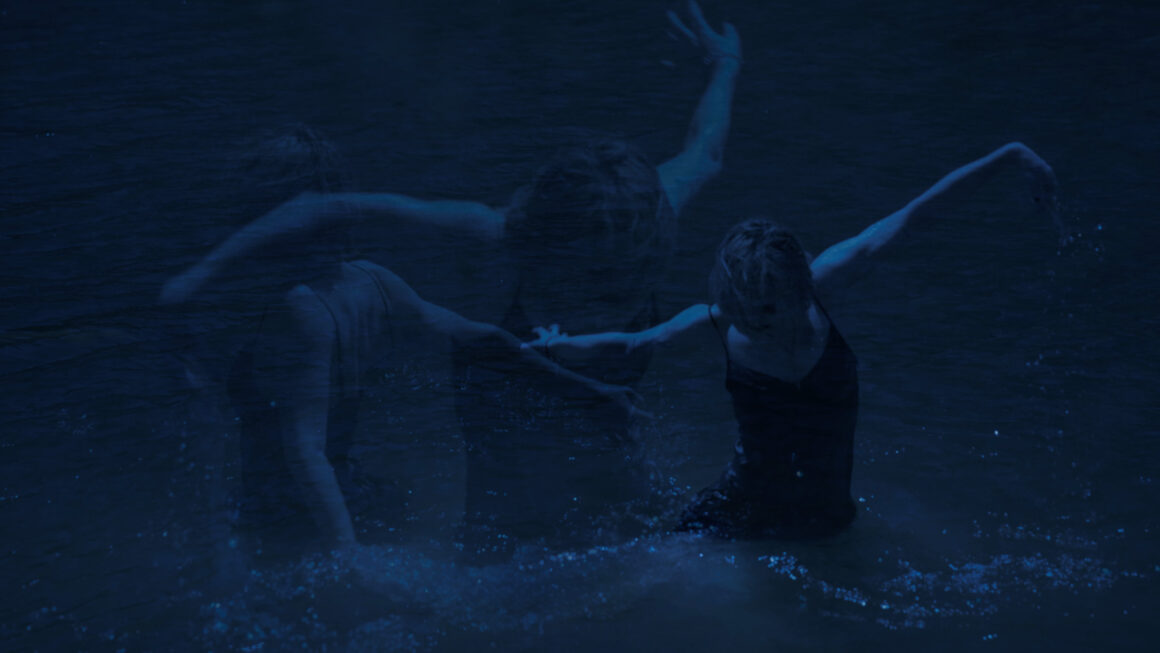
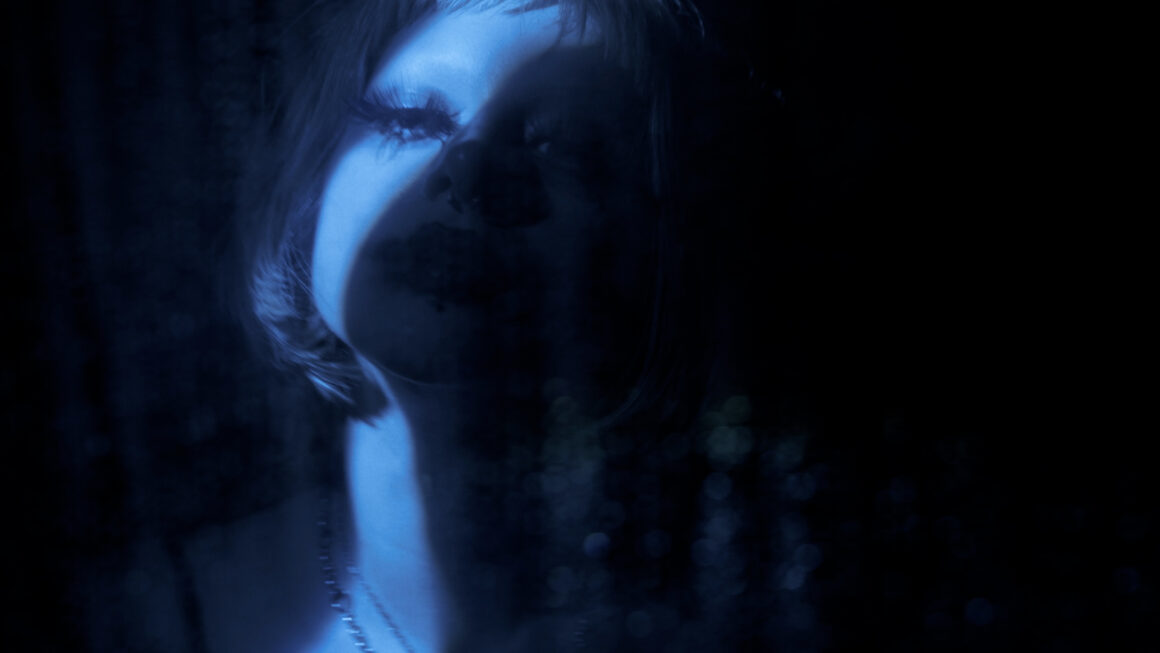
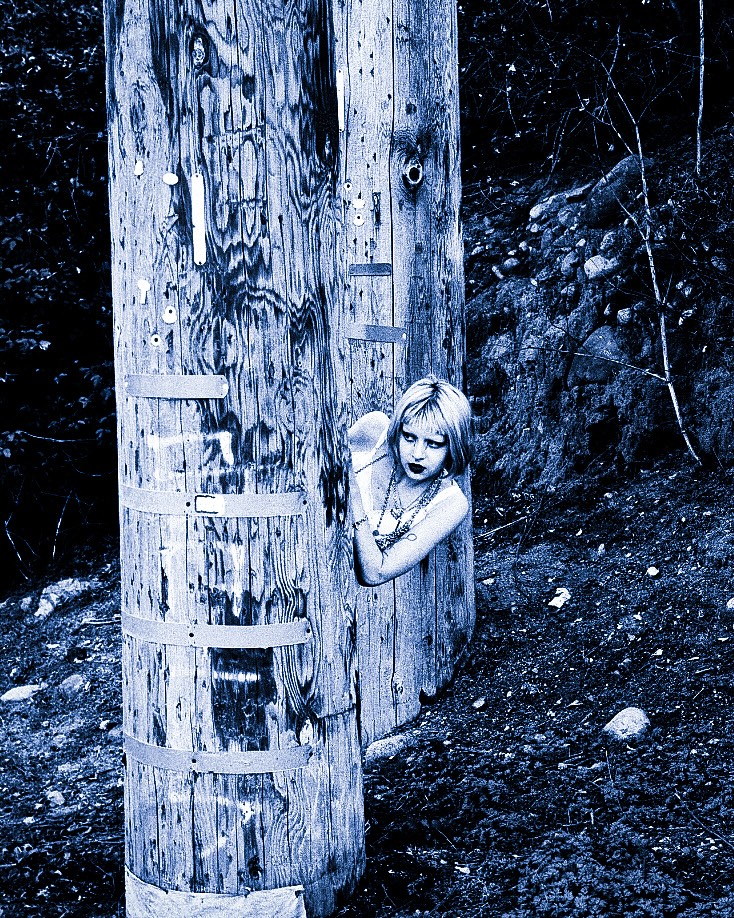
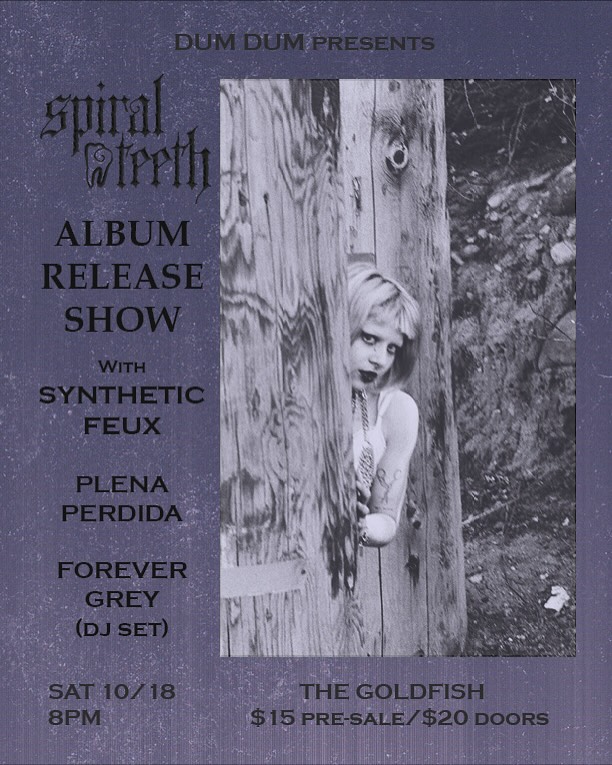
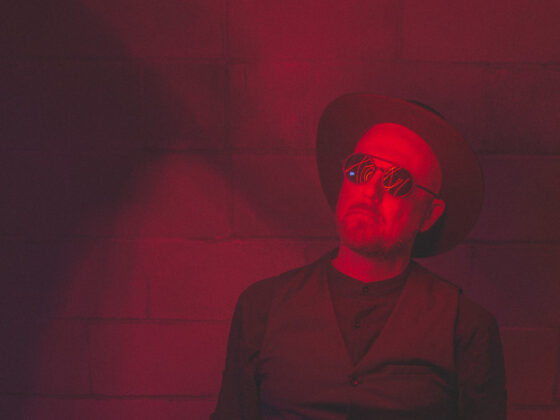
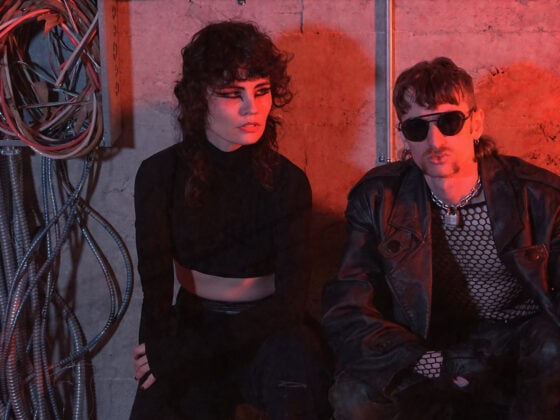
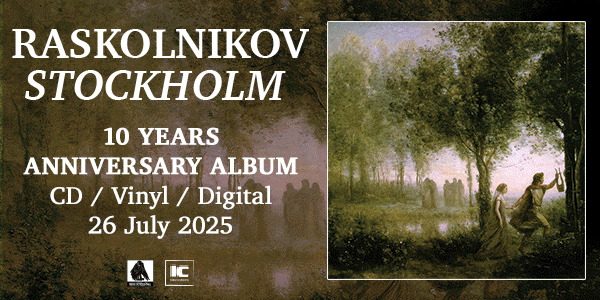









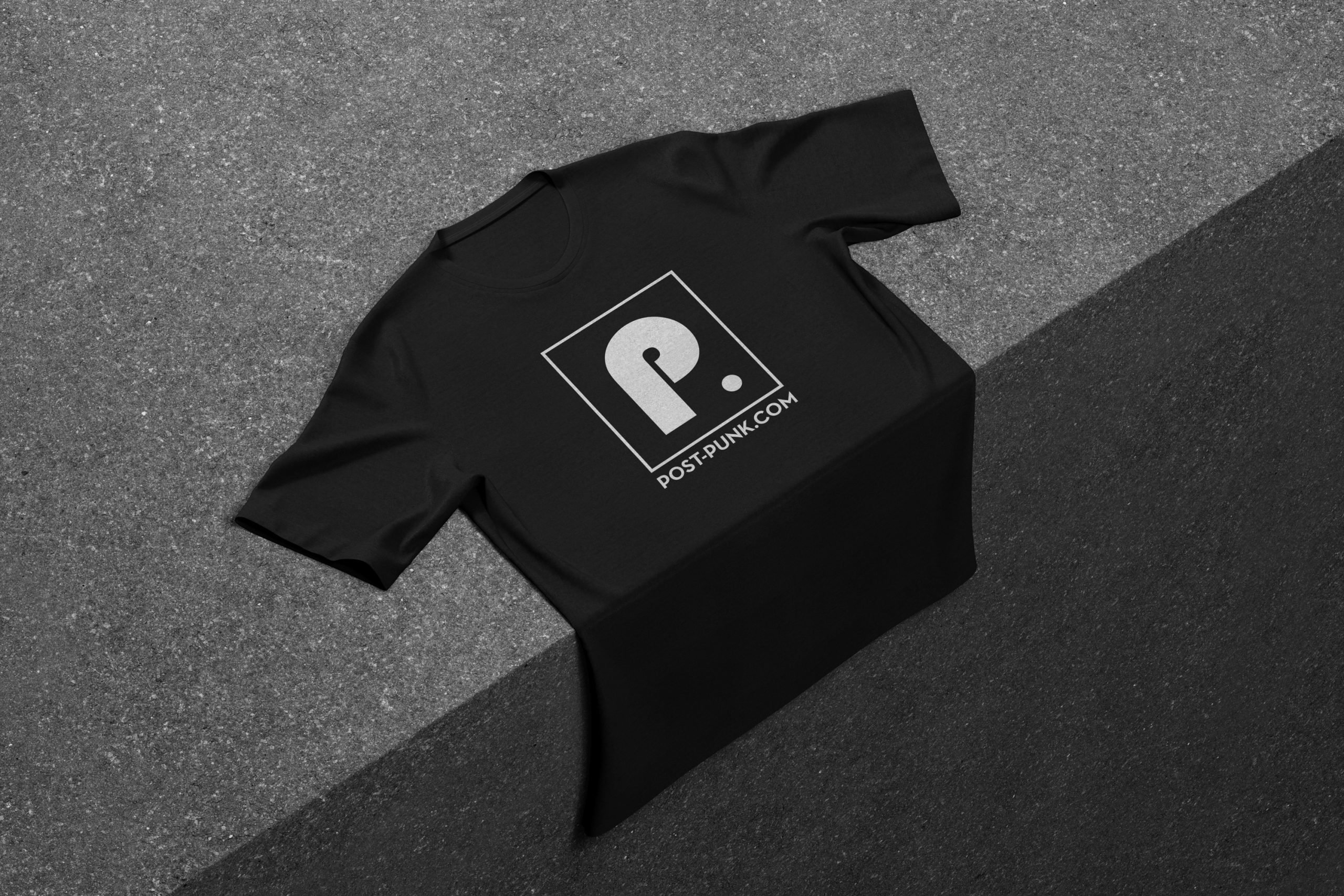 Or via:
Or via: